Japan travel requirements 2025: What travelers need to know
We aim to keep this post updated about Japan travel in 2025 with official Japan travel restrictions, requirements, and health and safety guidance. Our goal is to help you make informed decisions so you can travel confidently, safely, and responsibly in this new post-pandemic world of ours.
Since travel restrictions can vary by citizenship, we will be focusing our post on rules that affect U.S. citizens.
Last update: October 16, 2024. Originally published: July 2022.
Disclosure: This post contains some affiliate links. If you make a purchase through one of our links, we may receive a small commission, at no additional cost to you.
* Get our free Post-Pandemic Travel Checklist *
August 2024:
“Tourism in Japan is at an all-time high, so you should definitely expect to encounter larger crowds and longer wait times. This is especially true for popular destinations like Tokyo, Osaka, and Kyoto; however, this can also be felt to some extent in smaller cities such as Hiroshima, Kobe, and Nagasaki.It’s pretty much business as usual in the country, although you will still find people who wear masks, especially in more crowded areas.
Locally, there have been some travel restrictions implemented to help combat overtourism in more popular areas. Specifically, Kyoto and Mount Fuji have introduced regulations that aim to manage visitor numbers and limit access.
That being said, Japan is very open and welcoming to visitors.”
– Krysti of Wanderful Horizons, expat living in Japan
April 2024:
“Tourism is really popular in Japan these days, and crowds can be difficult to avoid. There are no more travel restrictions for Japan, so it’s a much simpler arrival process than last year.However, we still highly recommend filling out the Immigration and Customs form online for quicker arrival (see instructions below).
We showed our passports and QR code at immigration and customs, did fingerprints, and had no questions asked. Wifi in both Tokyo airports can be frustratingly slow, so it’s important to screenshot/download the QR code before departure so you can access it offline.
Just as it was pre-Covid, there is a percentage of Japanese people who wear masks out and about in public.”
– Michelle & Jedd, Intentional Travelers
At the end of the post, we share more on-the-ground perspectives from local residents and travelers to Japan so you can get a sense of what it’s really like.
Table of Contents
Is Japan open for travel? Can I travel to Japan right now?
As of October 2022, Japan is open for tourism for independent travelers. Visa-free travel for selected countries, including the US, has been resumed.
Tourists with U.S. passports can stay in Japan visa-free for up to three months. Find details and rules for entering Japan from other countries here.
Japan will introduce a new pre-departure requirement soon. Visa-exempt travelers will be required to submit an electronic travel authorization before departing to Japan. Check back for updates.
Japan travel restrictions have been eased but travelers are asked to follow guidelines with regard to masks, social distancing, dining etiquette, and more.
As of April 2023, a proof of vaccination or a negative Covid-19 test are no longer required for all travelers arriving in Japan.
To facilitate the arrival process, it’s highly recommended to submit your information online through Visit Japan Web before travel.
Steps for Traveling to Japan: What to Know (2025)
For a smoother arrival, travelers to Japan can pre-register for airport Immigration and Customs to receive the QR codes used for “Fast Track” at major airports across Japan.
We completed the Japan entry process in late March 2023 and again in early April 2024. It was admittedly a bit confusing, so I thought I’d share our experience and tips, as the process is still the same (apart from step 2).
1. Register at Visit Japan Web
While the Fast Track/Quarantine procedures are no longer mandatory to complete in advance, I was glad I followed advice to pre-register through the Visit Japan Web site.
The latest they say you can register is at least 6 hours ahead of your flight to Japan.
After creating an account with my email address, I had to enter my personal details, arrival date, and flight information.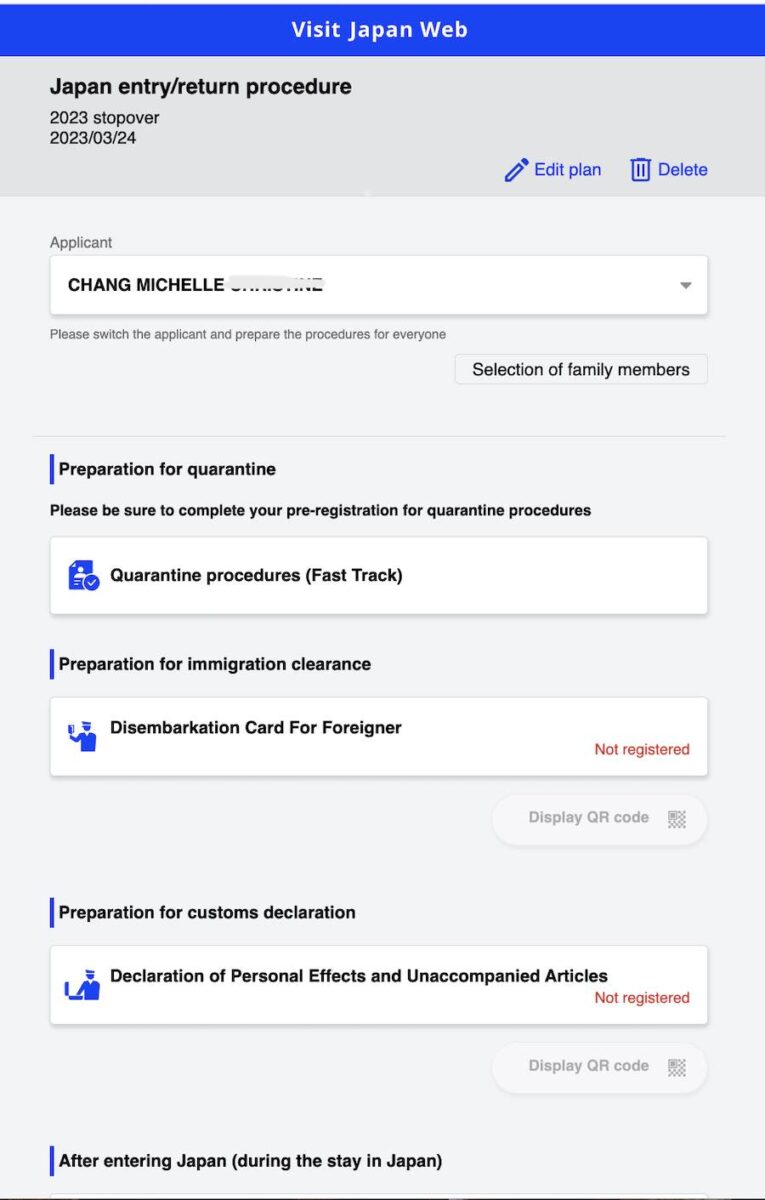
2. Submit your Covid documents in advance – NO LONGER REQUIRED
3. Register for immigration QR code
Returning to the main registration dashboard on the website, select the next module “Disembarkation Card for Foreginer,” which says it’s required for landing in Japan.
Some details pre-populated from from my profile. I selected Tourism for purpose of visit. Then there are three ways to report length of stay: year, month, day; as well as a few questions about any criminal background in Japan.
Once completed, a button “Display QR code” appears below the appropriate section.
Take a screenshot of the Immigration QR code and save it to your phone. It will have a yellow line above it.
If you don’t have the QR code, there are immigration cards available to fill out at standing desks located before entering the lines. Some people got all the way up to the immigration agent and were asked to step aside to fill out a card, which are also available next to each immigration stall.
The immigration line at Narita moved steadily but took about 25 minutes since several flights had arrived at once.
When I showed the QR code, the immigration officer simply took a headshot picture and fingerprint scans, then stuck a “landing permission” stamp in my passport for 90 days. No questions asked.
4. Register for Customs QR code
Returning again to the main dashboard, finally select “Preparation for customs declaration.” This registration allows travelers to go through an electronic declaration gate, which wasn’t super clear once we were at the airport.
I entered my flight origination (Hanoi) and number of family members with me (1). Then there’s the usual customs questions – type of goods, prohibited items, monetary funds, alcohol, cigarettes, souvenirs over 200,000y.
Again, take a screenshot of the Customs QR code and save it to your phone. It will have a blue line above it.
At Narita, the customs line for QR codes are labeled “electronic declaration” in blue. There are also kiosks that allow QR code, card, and duty free, as well as those that are for physical customs card only. The lines weren’t too long so it didn’t matter much which line we chose.
The customs officer had us scan our QR code and we could see our entered data displayed on an over-sized tablet-like device at the desk. No questions asked, we proceeded to exit the airport.
5. Sign up for travel insurance
It’s recommended to obtain insurance to cover medical costs related to COVID-19 in Japan. For travel insurance that covers Covid, we use Nomad Insurance by Safety Wing.
Quarantine rules in Japan: What happens if I get Covid?
Travelers are not required to quarantine upon arrival in Japan, provided that they are not suspected of having Covid-19. See details here.
Residents report that quarantine rules for testing positive may no longer be enforced anymore.
Previously, foreign tourists who tested positive for Covid while in Japan had to contact a local consultation center. A 7-10 days quarantine at a government-designated accommodation facility was required with all costs covered by the visitor.
The quarantine period could end within 7-10 days depending on the symptoms and/or negative COVID-19 test result. See details here.
Can I travel to Japan in February? Can I travel to Japan this Spring?
Travel to Japan in February is open. See details above and check back for updates.
Is it safe to fly to NRT Narita or HND Haneda International Airport? Health screenings and body temperature checks are no longer in place at the airport. Wearing of masks is no longer required on flights or in the airports, though masking is still widely practiced.
Stringent cleaning and seating limits are implemented.
What is it like to fly to Japan right now? All Nippon Airways reports that masks are now optional. Additional procedures are in place at Immigration – please see details above.
Do Americans have to quarantine when traveling to Japan? No. See quarantine details above.
Does Japan check COVID-19 symptoms of incoming travelers? Health screening procedures such as temperature checks and simple symptom questionnaires are typically not in place at ports of entry anymore.
Does Japan require a negative Covid 19 test for travelers? A negative test is no longer required to enter Japan as of April 2023.
Does Japan require a proof of Coronavirus vaccine for travelers? A proof of Coronavirus vaccine is no longer required to enter Japan as of April 2023.
Do I still need to provide a negative Covid test or quarantine if I have been vaccinated? No. A negative Covid test, quarantine, or proof of vaccination are no longer required to enter Japan.
Is a booster shot required for travel to Japan? No. A booster shot is no longer required to enter Japan.
What Covid testing options are available for travelers? PCR and/or antigen tests are available for travelers in Japan. Travelers should contact the local consultation center to determine the location of testing facilities within Japan. A list of some COVID-19 testing facilities can be found here.
Test results are available within 24 to 72 hours but many labs can return results in a matter of hours. PCR test costs vary from ¥2,500 to ¥16,500.
What healthcare options are available to travelers in Japan who get the virus? Japan hospitals and clinics are open. Foreign visitors are required to secure a medical insurance which that will cover medical costs in case they contract COVID-19 in Japan.
For travel insurance that covers Covid, check out Nomad Insurance by Safety Wing >
What service businesses and restaurants are open in Japan ? Businesses and restaurants in Japan are open. Some businesses may require their own mask rules or capacity limits.
What public gatherings are allowed in Japan? Public gatherings are allowed in Japan subject to safety guidelines.
Are face masks required in Japan? As of March 2023, wearing of face masks in Japan is recommended but no longer required, except in some healthcare facilities.
Face masks are almost universally worn in public, especially in urban areas, indoors and on public transportation. The Consulate website states that failure to adhere to mask-wearing norms reflects poorly on foreign visitors.
Are buses running in Japan? Trains, buses and taxis are running as usual in Japan.
How has the Coronavirus impacted Japan?
Japan managed impressively well compared to most countries in the early days of the pandemic. Although Japan has been previously in a State of Emergency, the lockdowns were less disruptive on Japanese daily life.
However, Japan’s inbound tourism business lay dormant for years. Japan finally began easing restrictions in 2022 and reopened to travelers in June with strict entry requirements.
Japan finally eased entry requirements for travelers in October 2022 making it easier for travelers to visit the country. Visa-free travel has also been resumed for select countries.
Vaccination in Japan started later than some other countries. Around 80% of the population has been vaccinated and 64% had received a booster shot.
Tourism is now back with record numbers of visitors, however, staffing shortages have not fully recovered.
For the current situation in Japan, including: total COVID-19 positive cases; total cases in Japan; and COVID-19 testing in Japan, please see the Japan Ministry of Health site.
What should you pack for safely traveling in Japan?
😷 Face Masks -Face coverings are recommended and widely used in public places.
Find N95 masks at Bona Fide > or designer options at Vida >
💊 Medicine – Bring enough prescription and over-the-counter medication for your entire trip to avoid trips to the clinic.
💳 Vaccine Card Holder – Protect that paper CDC card when traveling abroad (if your country doesn’t offer a digital version).
Get a simple plastic protector > or Vegan leather clippable > or Leather passport + card combo holder >
👃 Covid self-test – The most studied rapid antigen self-test with FDA emergency authorization. NOT valid to enter countries. Use for your own peace of mind.
Order from CVS > or Walmart >
💧 Sealed water bottle – Make sure your reusable water bottle has a lid that’s not exposed to the air. We use one of each of the following:
Shop insulated water bottles with protective lid >
Shop water bottles with purification filter and protective lid >
✈️ Travel insurance that covers Covid – We’ve started using Nomad Insurance by Safety Wing for affordable evacuation, international medical, and trip coverage.
ᯤ Stay connected with an eSIM – learn more and look for our discount code in this eSIMs for travel post.
TIP: Traveling abroad is much easier when our smartphone stays connected.
If you have our WorldWide Connectivity course (also available inside our Membership), review the modules on eSIM Best Practices and Managing Data Usage to get the most out of your eSIM!
What do Japan locals and recent travelers say about visiting Japan now?
What is it like to visit Japan right now? It’s our goal to provide regular updates here from real people on the ground, to help potential visitors know what to expect. The following are subjective opinions only. Official travel guidance can be found above.
January 2024 – Brandon of Zimminaroundtheworld, expat living in Japan: “Japan is seeing an increase in tourism now that the country is open to visitors. Many visitors are traveling to Tokyo and Kyoto but some towns and cities like Nikko, Fukuoka, Hiroshima, and Naha are also seeing rises in tourism.
Currently there are no travel restrictions within Japan unless it is due to environmental catastrophes like the earthquake that occurred in Ishikawa Prefecture recently. Access to healthcare in Japan is easily available and affordable. Although foreigners can sometimes pay up to 200% more for healthcare it is still cheap.
Many attractions and famous sites around Japan especially in Kyoto and Tokyo are crowded with lines that are longer then expected. In general, restaurants in Japan are smaller and can only able to accommodate up to ten people or fewer and the space can feel cramped. Like anywhere else, keep an open mind and be flexible and there will be no problems while traveling around Japan.”
September 2023 – Jackie Szeto of Life of Doing, American traveler: “My husband and I traveled to Tokyo and Nikko, Japan for vacation in September 2023. Expect large crowds at major attractions, restaurants, and trains in major cities such as Tokyo and Kyoto. Visiting other destinations such as Nikko is a nice change of pace with fewer crowds, especially on the weekdays.
It’s recommended to complete the Immigration and Customs declaration on the Visit Japan Web to expedite arrival, but it’s not required. When landing at international airports, the QR codes for Immigration and Customs are still accepted. Otherwise, all COVID protocols have been dropped in the cities. Antibacterial hand sanitizer is still provided at entrances of hotels, restaurants, and shopping centers. Some people still wear masks in crowded areas and on trains, but most go mask-free.”
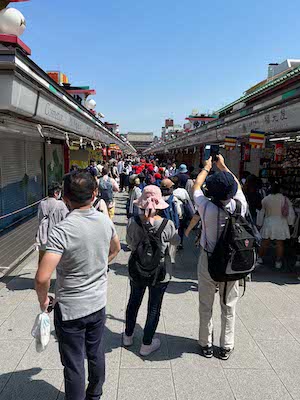
May 2023 – Sophie Pham of Delightful Travel Notes, traveler: “My husband and I were traveling in Japan for 11 days from May 11-21, 2023 for our vacation. I found that Japan had already welcomed visitors with open arms, free of earlier restrictions. The return of both domestic travelers and international tourists created a lively atmosphere, and crowds could be seen in a lot of places.
In May, it took us 45 minutes to clear immigration at Kansai International Airport after landing at around 7:45am.
All attractions and food venues were fully open, with no social distancing measures or mandatory mask rules, although some restaurant servers, locals, and taxi drivers still chose to wear masks. Some famous restaurants had long lines again, and popular attractions like Fushimi Inari, Kiyomizu-dera, and Senso-ji-ji could get crowded during the day. If there’s a particular popular restaurant you want to try, it may be best to make your dinner reservation in advance, especially for weekend. Overall, everything is lively again and we had a great time.”
March 2023 – Michelle, Intentional Travelers, American visitor: “We enjoyed a two day layover in Japan. The online procedures and QR codes were a bit confusing but I highly recommended doing them in advance of travel to make your arrival smoother.”
February 2023 – Joel, US traveler: “For the most part the Japanese are wearing masks. I’d say mask wearing is at about 99%. Despite the crowds in the city and packed trains and subways, it honestly feels way safer than generally any place in America where mask wearing is far from the majority. ANA enforces a mask wearing requirement whereas United is pretty much a free for all.
One key thing that is good to know is at the ticketing counter they need to know your return flight info when initially checking in. We had all the other Japan travel docs as far as the gov mandated requirements but this one kinda caught us off guard. The immigration line may seem staggering but it moves.”

January 2023 – Lizzie of Wanderlust & Life, UK traveler: “I flew to Tokyo in January 2023 for 3 days as part of a stopover between Australia and the UK. For us it felt like the country is so happy to welcome tourists again. We were slightly worried about visiting or entry restrictions changing last minute but the airline kept us up to date and apart from filling out a lot of forms on arrival it felt quite normal being there.
As Japan only opened recently there weren’t as many tourists as we were expecting which was a plus really. We were made to feel so welcome in the country.
Masks are mandatory indoors and everyone seemed to be following this. The vast majority of people were also wearing masks outdoors too. Sanitiser is readily available in restaurants and tourist attractions. We didn’t encounter any contact tracing or even requests to show covid passes. The only frustration we had was that we flew JAL and we had to wear masks our whole flight which was about 14 hours in one go and this was enforced by cabin crew.”
November 2022 – Darryl H., New Zealand traveler: “My visit to Japan involved a return to the sort of measures that, in my home country of New Zealand, had been abandoned some time ago. The first action on arriving at Tokyo’s Narita Airport, with my mask firmly in place, was to allow officials to check and confirm I had complied with mandatory online registration of evidence of my vaccination status. Once this had been done, the arrivals process was pretty much standard.
During my 10-day stay, I experienced no restrictions on my movements or activities. The differences were in the roles of masks, sanitiser and – in some instances – distancing. The wearing of masks indoors and on public transport is close to one hundred percent, whether or not they are demanded. Outdoors, in most situations, they appear to be worn by at least 98 percent of people, although in some areas later in the evening there is an obvious relaxation in standards – especially among younger people. While most tourists appear happy to comply with the standards followed by locals, the proportion of non-mask use by non-Japanese is clearly larger than by Japanese. At no stage did I see any visitor reproached for this.
There is sanitiser on hand (pun intended) everywhere. It is probably accessed by about a third of people. There are many locals who are fastidious about sanitising.
While I observed no enforced distancing on public transport or in the street, it is definitely in place in cafes and other eateries. Most places I visited had plastic partitioning between patrons, and crosses to discourage the use of every second seat. Groups or couples are, of course, welcome to sit together.
The buffet breakfast in my hotel illustrates all three of the above differences. When I arrived at breakfast each morning, masked of course, the attendant ensured that I first sanitised my hands and then put on plastic gloves. Only then could I approach the serving implements and food. I would then sit on one of two seats (the second having a cross on it), both of which were partitioned off from the next pair of seats. Seats with another seat opposite were separated by another plastic partition. If I wanted to return to the buffet for more food, I first had to remask and re-glove. Once I forgot the gloves, and was politely turned back before I could touch the serving implements.
It is not uncommon for Japanese hospitality venues to give high priority to cleanliness, but there seems to be super-high priority now. Where in New Zealand I might expect a quick wipe over of a table between customers, in Tokyo it now appears to be a thorough and sometimes deep clean.
The precautions in no way reduced my pleasure in revisiting Tokyo. And they increased at least my perception of being protected.”
September 2022 – Jackson, American visitor: “Traveling to Japan reminded me of the COVID situation in Hawaii a year ago. People go about their day with a medical mask. Every store front has hand sanitizers and thermo cameras. COIVD testing and vaccination clinics are common place. Despite these COVID precautions, Japanese residents and businesses continue to welcome visitors with refreshing grace and hospitality. Japan’s omotenashi, beautiful scenery, and extraordinary delicacies are worth exploring and appreciating, but can tempt visitors into overlooking the uncertainty that underlines Japan. I hope visitors will take the time to learn about the challenges of the Japanese people and reciprocate Japan’s hospitality with a gracious thank you.”
Aug 21 2022 – Y., American Japanese dual citizen: “I returned from visiting family in Japan two days ago. Travel is still tough. The plane was empty – only 20 passengers on a big airplane. My pre-travel Covid test was 10 minutes earlier than the required 72 hours so I was turned away at the airport. I scrambled to find a last minute PCR test with rapid results and rush back to the airport.”
August 2022 – Christine, American visitor: “Japan isn’t currently open to tourists. I was there for a school conference, and had to get a conference visa. One has to get a visa for Japan in advance and you can only get one with an EFRS form filled out from someone in Japan.
I had to have a negative PCR test from within 72 hours of departure time. There’s eased quarantine procedures, which depend on the countries you’ve been to in the previous 2 weeks. And you have to have the MySOS app on your phone because they might check up on you. It also expedites your entry because you can upload all the necessary forms/COVID test/questionnaire ahead of time.
Everyone wears a mask everywhere, and they’re available for cheap at convenience stores. Because I was on a university’s campus most of the time, I had to report my temperature and if I was having any symptoms to the University every day.”
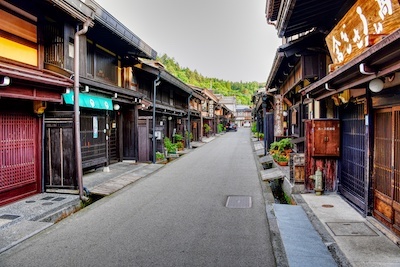
July 2022 – Brandon of https://zimminaroundtheworld.com, Expat in Japan: “Currently Japan is only doing guided tours for international tourism. Travel entry for normal tourism is not an option at the moment. I recently took a trip around central Japan and visited a variety of cities and saw hardly any tourists. It’s nice to get great photos of popular attractions without crowds of people in the photos. But at the same time, it is taking a toll on the economy. I’ve seen shops and restaurants struggle to survive here and locals begging for tourism to come back.
Masks have been worn in Japan even before Covid. To this day, the majority of the population wears masks and obeys the rules, this includes both foreigners and locals. I wear a mask when leaving my apartment and only take it off when social distancing can be achieved or while eating at a restaurant. The positive aspect about Covid is that there are no long lines to enter attractions or eating establishments. I feel public transportation is safe here as the Japanese are very good and sanitizing everything.”
Planning a trip to Japan?
Check out our other Japan travel resources:
– Great Things To Do Around Iwakuni, Japan
– JAL Premium Economy Review Haneda to Hawaii
– Hawaiian Airlines Business Class A330-200 Review Honolulu to Narita
If you have questions or updates about travel to Japan during the Coronavirus crisis or post-pandemic, please let us know in the comments below.
~ Pin this post for later or share with friends ~
Disclaimer:
Please note, travel restrictions change frequently. Readers must take responsibility for verifying information through official sources like the State Department and CDC, in respect to their specific situations. No responsibility can be accepted by Intentional Travelers for action or inaction as a result of information provided through IntentionalTravelers.com. Any information provided here is issued as general information only.

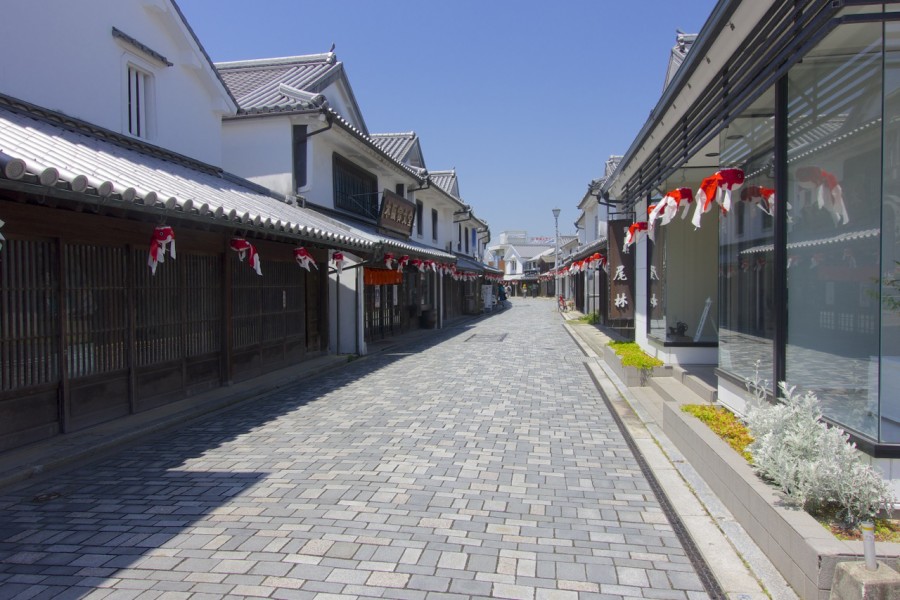
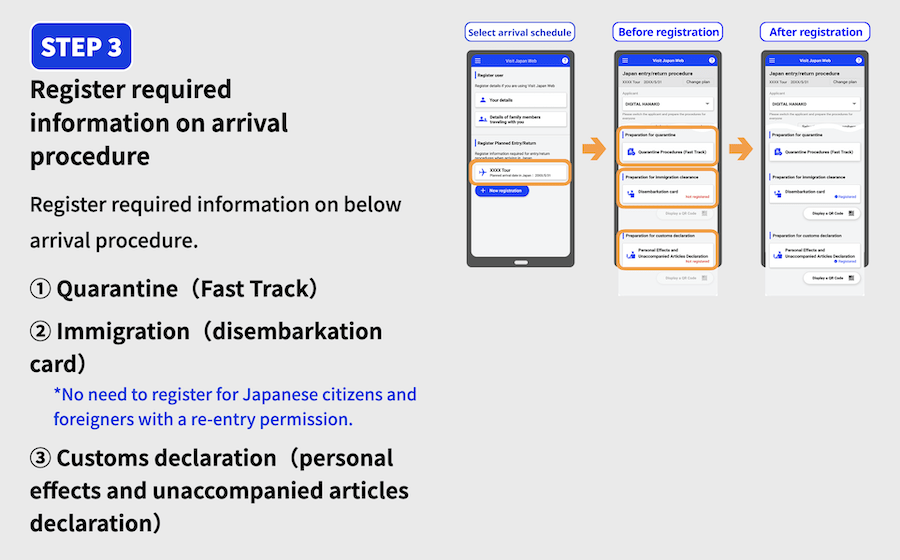
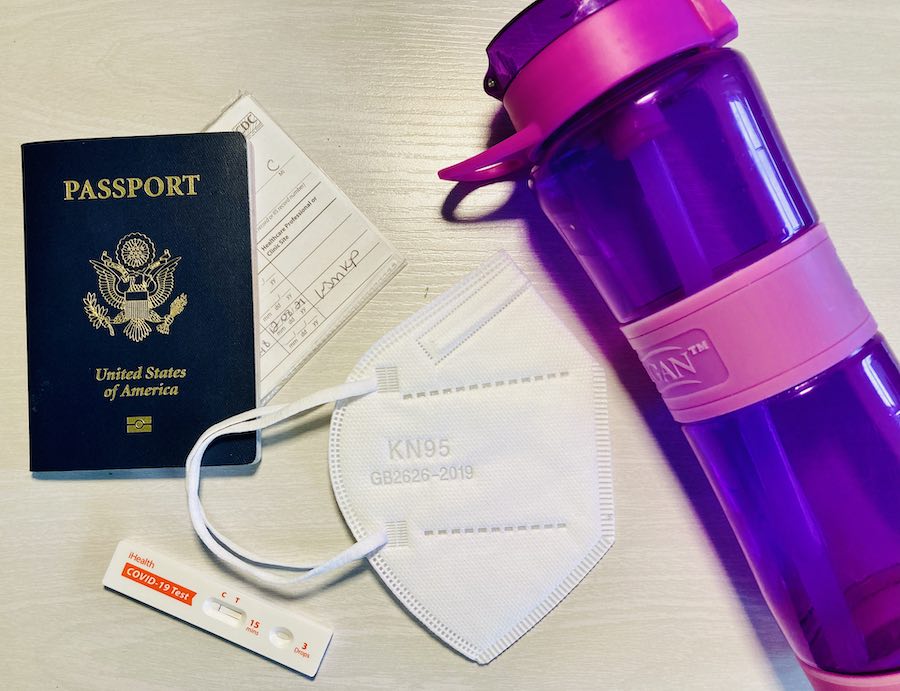



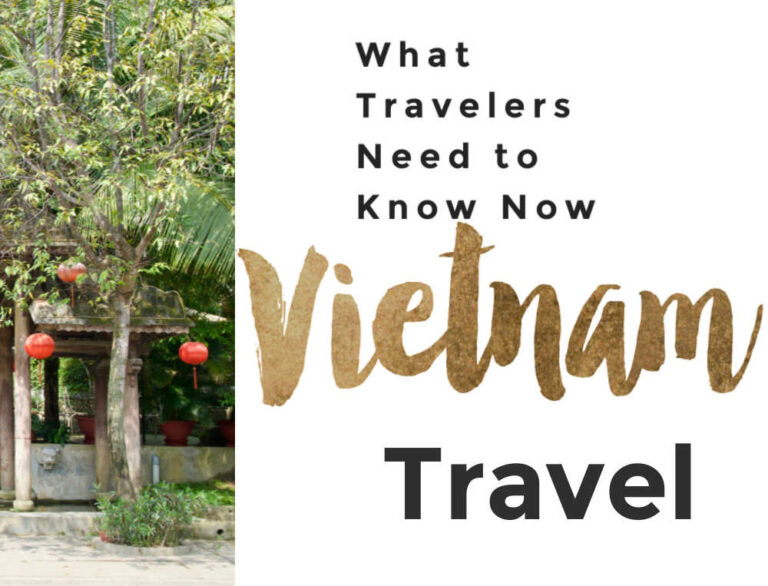

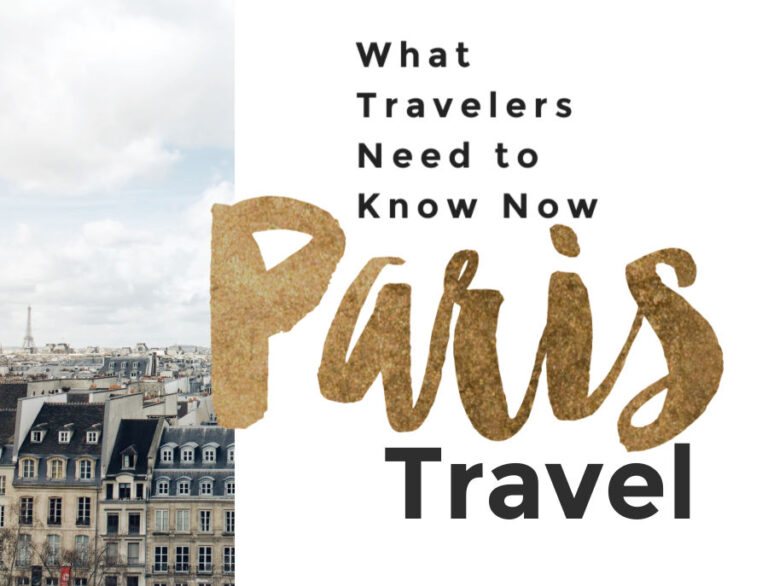

Hi Great article ! I noticed you have been vaccinated once with JJ (same here) . You mentioned the requirements for boosters but it sounds like you haven’t had a booster?
I tried to sort through the link page but couldn’t find any further info.
So my question is I’m planning to travel after May 8th with 1 JJ vaccination, I’m Canadian, but will be coming from Indonesia.
Thanks for any insight you might have
Hi and thanks for visiting our blog. While we had the single JJ vaccination, we also had boosters. I mentioned it because the Japan entry form allows you to essentially count JJ as two shots out of the three that are required. In other words, at least one booster is currently required for entry to Japan. That said, vaccine documentation will no longer be required after May 8 so you shouldn’t have to worry about it.
Hi there,
I am travelling to the US from Australia via Japan in September. I fly with JAL, from Melbourne (MEL) arriving at Haneda International Airport (HND), but need to fly out of Narita International Airport (NRT) to New York (JFK).
I would like to know if I will be allowed to travel, via Japan, in September.
Australia is in Blue Category and I have had 3rd dose of Covid vaccination.
I look forward to your reply soon.
Chi
Thank you for your question. Unfortunately, it’s difficult to say what will be possible in September, as we do expect the rules to change over time. Currently, foreign travelers are limited to package tours and may not use public transit. To find out if any exceptions can be made for transit between airports, you can try the Japan visitor hotline.